Posted on April 01 2023

Cycling Tour Spain, France, the Pyrenees
The first of our own independent cycling tours. In reflection this was the first “Connal Tour” and some of the inspiration that was to result in the development of our cycle clothing brand Connal Kit. This year, we changed our normal ‘big trip’ to Europe and kept our focus on just two countries (Spain and France) and in particular the Basque country and the Pyrenees. We’d recently upgraded our road bikes and were excited to take them with us, to test them (and ourselves) on the Col du Tourmalet, an iconic climb often included in the Tour de France.
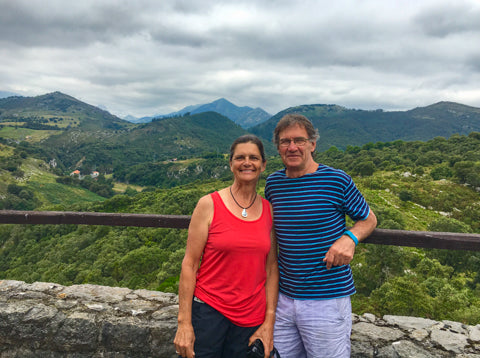 |
Other ‘must dos’ which dictated our trip planning were to visit the wine region of Rioja, visit Pamplona (once read about in “The Drifters” book by James Michener), see the Guggenheim Bilbao museum, do lunch at the Michelin Starred restaurant of Etxebarri in the Axpe Valley (recommended by a very good chef friend, who happened to know an Aussie chef who had worked there), go to Guernica and view Picasso’s work, visit Carcassonne, see Salvador Dali’s art in his home town of Figueres in Catalonia, spend some time in Barcelona (we had both visited Barcelona several times before and had fond memories). We were excited with the prospect to nurture our passions for cycling, wine, food, nature, mountains, art, architecture, culture, language and history. The rest of the trip was to fill in around these ‘must dos’ and discover more roads to cycle. It was going to be a case of knowing where we are starting (and finishing), but not where the path will lead us. From Perth we flew into and returned from Barcelona in Spain. Qatar Airways was wonderful with friendly service and taking great care of our EVOC bike bags full of bicycles and luggage.
The plan - we hired a hatchback car, drove to pre-planned mini-bases and then explored around each of these on our Merida Road Bikes. Touring by bike is such a sensuous way of sightseeing!
It was straight to our first destination of Ainsa in Aragon, Spain. A delightful, small medieval town with a backdrop of mountains. With a load of nervous energy after negotiating the drive out of Barcelona, it was great to sit back with the first beer in Spain and take in the night sky, views of the Pyrenees, and the twinkling lights of the village. After months of planning, we were finally here, in Spain. Summer heat, lush green hills, terraces, views to the Pyrenees, sunset, full moon, beer, tapas, castle, old stone houses, forests, the romantic intrigue of a region called Aragon, once the Kingdom of Aragon.
 |
Cycling Day 1 Ainsa 4.5km test run. 20th July
Waking early, before dawn, with our altered body clocks realising, yes, we were actually in Spain. Eager to start our adventures, we needed to unpack our bike bags and rebuild our bikes ready for the rest of the trip. Watching the sunrise over the Pyrenees and the Castle, we drove to some open space in an empty carpark. With wheels back on our bikes we took them for a short spin around some walk tracks, past some farms and vineyards. To make it easier throughout the rest of the trip, we made the bike bags as small as possible, and the bikes were loaded into the car with front wheels removed. Note to selves: all future bookings which involve hire cars and bikes – make sure the cars are large enough to take 2 bikes plus the empty bike bags, plus extra luggage, plus ourselves.
Our bikes, nicknamed for this trip as M1 and M2 (M=Merida), had a voice on our facebook posts made at the time – where the daily adventures were written in their voices. It generated much comment and laughter from the folk back home who knew us well, but I won’t confuse you with that form of writing here. The sometimes-derogatory comments from the bikes about their riders could confuse the reader.
Drive - Ainsa to Anso
Leaving Ainsa we travelled up and over the hills and through tunnels to the city of Jaca and on to the medieval hilltop village of Berdún – town walls with open portals, stone houses, wind swirling leaves through the cobbled streets and forming leaf whirlpools in the small central square. It was a village for walking, following the narrow streets, winding our way further towards the middle, but with endless streets and houses seeming like a maze. At one point we felt we should have left a breadcrumb trail. The village looked over an expanse of farmlands and crops.
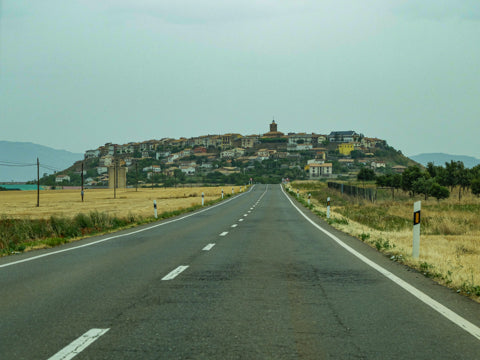 |
From here we turned north and followed the Valle de Anso, along the Rio Veral through the scenic Foz de Biniés, the narrow canyon road passing through primitive stone archways, sheer vertical rock sidewalls to our left and the bubbling mountain river to our right. A reminder of home with the shrill noise of cicadas in the steep river valley, water was cold, clear and refreshing as we waded in over the glacial stones. Butterflies fluttered amongst the greenery and Griffon Vultures were circling and soaring over the high rock walls. The small town of Anso was welcoming with its bright geraniums and hydrangeas, cobbled streets, stone houses, chimneys, and children playing in the field. Again, a backdrop of the Pyrenees looming nearby, rain and a thunderstorm to complete the picture and give rise to more comforting tapas and red wine.
Cycling Day 2 - Anso - Zuriza - Anso 30km 450vm 21st July
First, leaving our accommodation, we simply reparked 200m down the road and took our bikes for a spin up the Anso Valley to Zuriza with some surprising 8-9% gradients which assured some spectacular surrounds - alpine meadows and the Zuriza Forest (pines, beech and fir trees), the river, and views of the Pyrenees peaks, all part of the Parque Natural de los Valles Occidentales. Riding between 2 peaks and over a cattle grid brought us out into the valley of Zuriza – like a hidden Shangri-la. A hidden gem in beautiful surrounds. Bonus – the return ride was of course all downhill. Back in the village of Anso we refuelled ourselves with coffee, standard travel fare of bread/cheese/tomato and some tasty fresh nectarines.
 |
Drive – Anso to Pamplona
After repacking the bikes we drove up and over the mountains to Roncal in the autonomous community of Navarre. The landscape changed to open, wider, flatter and deforested. Stopped at a bridge at Asperz for a swim before driving up to the village where the streets kept narrowing until we were faced with a stairway descent or a multipoint turn around – the streets of car chases in movies.
Our next stopping point for a couple of nights was the city of Pamplona. Larger than we expected, and from 7pm the streets began to buzz with crowded tapas bars opening onto the streets, young ones seated on the ground, full of friendship and conversations. A day of walking took in the Plaza del Castillo (beautiful old city plaza with a central pavilion), City Hall, the locations used in the Festival of San Fermin (Running of the Bulls), Plaza de Toros and the bronze Monumento al Encierro, the River Arga with stone bridges, open space in the Parque de la Taconera, the Citadel (Ciudalela) fort and city walls, oak trees, park sculptures, the passing parade of humanity – walkers on the Camino de Santiago, families, couples, cyclists, singles, groups of young people, all kinds enjoying this lively city (especially at night).
Cycling Day 3 Alsasua-Olazti/Bos Urbasa 15km 23rd July
Having left Pamplona, we spotted on our gps a potential quiet cycle through a forest near the villages of Alsasua and Olazti. The tops of the hills were in the clouds – to which we headed, driving up and up around switchbacks to reach Bos Urbasa – the forest on the top of the rocky, steep hillside. Parking, we then cycled the roads through this forest, but the roads deteriorated to rocky limestone tracks and finally became an open cow field, on the high open moorland. It rained, we got wet, it was time to turn around, and dodging puddles and sloppy cow shit, return to the car, trying to clean our bikes and ourselves. Then back down the hillside to find a bar to warm ourselves with coffee and food.
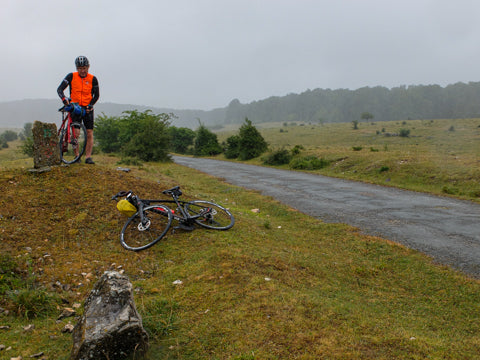 |
Drive – Pamplona to Zarautz
Time to head north into the province of Gipuzkoa and the Basque Country (Euskadi) – home to the oldest ethnic group in Europe ignoring country borders. Zarautz on the Atlantic Coast was our next destination, where we stayed for 8 nights to explore this amazing region. We chose Zarautz as a smaller version of the region’s capital Donostia-San Sebastian which appeared too busy, too large and too touristy for what we needed. Zarautz had it all. Wide beach, colourful sunshades, art works along the promenade, Old Town with elegant architecture, lots of bars and restaurants, a mountain backdrop, just on a smaller scale. Here we discovered the wonderful process of going out for Pintxos – maximum flavour in very small portions of a variety of foods ordered or just taken from the bar with a drink, then moving onto the next bar and doing the same. Also Txakoli – the local sparkling white wine. The pavement cafes, bars and restaurants with proximity to the promenade and the beach, create a colourful, moving collection of people as they gravitate from bar to bar, tasting all that is on offer. We learnt to watch what the locals are eating and do the same.
 |
Cycling Day 4 Zarautz – Urdaneta Only 12.5 km but 480 vm 24th July
As we were based several kilometres out of town (and up a hill) at a farming property hosting AgroTurismo, we decided to explore the rural roads of our neighbourhood. Well, we started going uphill, the road was hardly wide enough for a single car, looked and felt like hand laid cement with gutters across every 50cm. Up, up, and up we went. With gradients registering as 12, 13, 14 and up to 17%. Requiring a weight shift to keep the front wheel on the ground at times. Finding a loop to return us home it was a relief to go down again. We didn’t take that route again.
 |
Things get a little complicated in the Basque Country with a dual language system which means dual signage. The Basque language reportedly the oldest living language in Europe. With the sun not setting until 10pm our daylight hours for sightseeing were long. An afternoon excursion by car to Donastia San Sebastian coincided with a jazz festival, hordes of people, promenade along the coast from Mont Igeldo around La Concha Bay to Mont Urgull and over the river mouth to Zurriola Beach. The Old Town, beach, people, boats, umbrellas, music, bars, pintxos and wine.
Cycling Day 5 Loiola Auzoa – Bolibar & Return 31km 600vm 25th July
The beauty of having a car plus bikes meant today we could do an exploratory drive to take in the Basque coastal scenery with lush green hills rolling down to rugged Atlantic coast with cliffs, coves and river inlets. Getaria, Zumaia, Deba, Mutriku, Ondarroa, Lekeitio and finally inland to the historic town of Gernika (Guernica). With a chilling and sad history of German Nazi and Italian air forces practice bombing session in 1937 during the Spanish Civil War, at the request of the Spanish Nationalists. An experimental horror that destroyed the village without warning and killed or wounded a third of the inhabitants. A special piece of art was created by Pablo Picasso depicting the evil of this destruction and the Oak Tree of Gernika (Gernikako Arbola) stands as a symbol of the traditional freedoms of the Basque people and their historical territory.
To lighten our day after these sad discoveries and the haunting feel of such past tragedy, we proceeded to a recommended road to cycle to absorb the beautiful surrounds – 15km up on 6-7% hills, switchbacks, a good surface and little traffic.
Returning to our car the return drive took us through the coastal town of Ondarroa.
 |
The next day after parking in a covered carpark in Zarautz, we discovered our hire car had a flat tire – no spare was in the boot. We needed to extricate ourselves from this covered carpark which we did with a few strange looks and finger pointing. Parking ourselves on a more accessible road on the outskirts of town which just happened to be outside a car dealership for this very same model of car. But no, nothing was simple. This then took out a day of our trip, as we had to wait for a tow truck to be sent to pick us up, return the car to Donastia San Sebastian and have a replacement car organised. We couldn’t believe it – all for the sake of a spare tyre not being included with the car. I guess not all customers are as capable as a couple of ex farmers from Australia. On the flip side, our replacement car was a little larger and being a Skoda was soon nicknamed Skoda Team Car.
Cycling Day 6 Urdaneta to Altzola and return. Only 8.5km and large lunch. 27th July
A very short ride this morning in the hills behind Zarautz. We stayed high in the hills in the Pagoeta Nature Park. The rest of the day was taken up with the best dining experience we have ever experienced. An early birthday treat, with lunch at Asador Etxebarri in Axpe Valley. The tiny village of Axpe with stone buildings and the backdrop of lush green mountains is home to this Spanish Wood Fired BBQ restaurant consistently among the top 10 in the World’s 50 Best Restaurants List. The chef (Victor Arguinzoniz) is a self-taught local, a master of fire, using own and local produce, fresh and quality with a daily changing menu. Hot coals are created from using multiple types of wood to create different flavours. 18 courses plus extras with beer and wine matching. Mind blowingly good.
 |
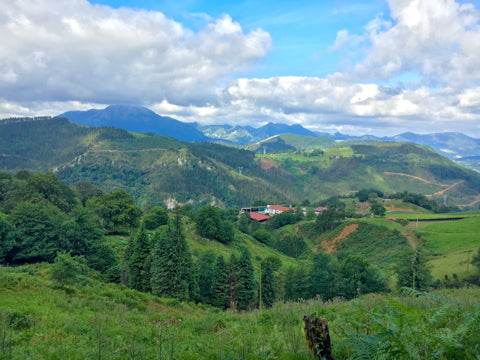 |
Cycling Day 7 Zaurutz – Getaria – Zumaia – Duba – Mutriku – Zarautz 70km 833 vm 28th July
As we had done several recce drives of the coastal roads a cycling route was set. Following the coast to the West, mainly through the coastal fishing villages. Because of the landscape with mountains rising from the sea, the coastal route had it’s hilly challenges. Narrow, winding road but the traffic was incredibly patient and considerate. Buses, trucks, camper vans, cars all patiently wait to pass and give us the 1.5m clearance required. Some amazing geological formations called the Flysch. A UNESCO classified Geopark Natural Heritage area where erosion of the sedimentary layers by the ocean and time have exposed the history of the earth like leaves of a book. Old town and port of Mutriku.
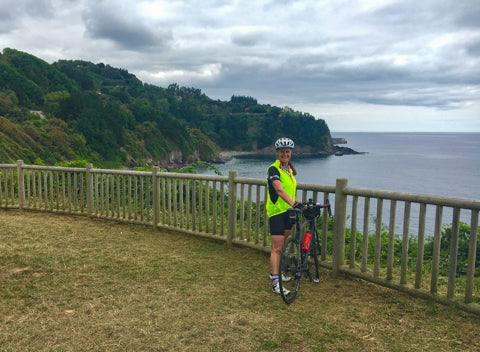 |
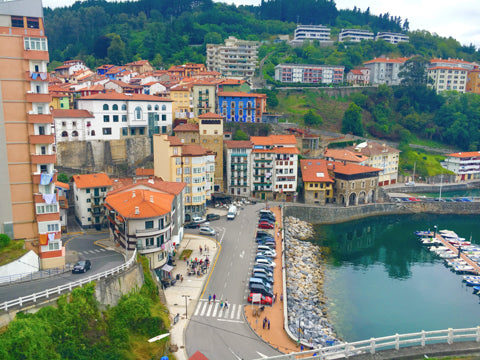 |
Our cycling route helped to work off yesterday's lunch. An afternoon drive up into the hills to find Aia - bathed in evening sunlight. Then down to Orio for legendary Basque BBQ fresh fish. So fresh it came with a hook in its mouth! It was good to ride the ocean roads today and feel the salt breezes again, even though a different ocean to home. Every valley holds new beauty. This Basque Country is addictive.
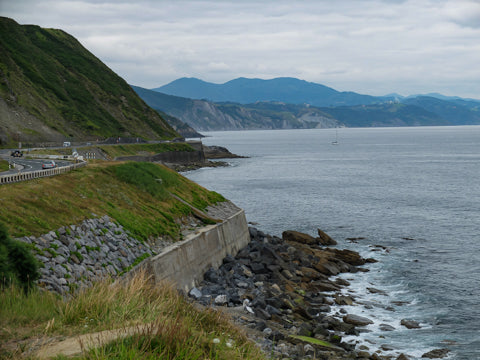 |
Drive to Bilbao
The next day was a car trip to the City of Bilbao. the glories of the Old City, the 7 streets, the amazing food market, the city architecture and the world-renowned Bilbao Guggenheim Museum/Gallery, the Theatre, beautiful riverwalk, sculptures. The architect Frank Gehry designed the Bilbao Guggenheim with striking sculptural lines and striking construction in stone, glass and titanium, sited on the banks of the Nervión River with its magnificent La Salve Bridge. It is a light filled and welcoming space with a large central atrium and connecting winding bridges and staircases. We later came across other stunning buildings designed by the same architect. The luxury hotel Marqués de Riscal, Elciego (which we were soon to visit); The Olympic Fish Pavillion in Barcelona; we had also seen his stunning design at the Dancing House, a well-known landmark in Prague.
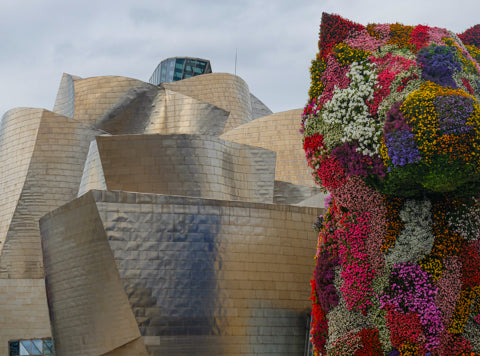 |
Cycling Day 8 Andoain – Leitzaran Valley 50.5km 458 vm. 30th July
We set out to find the Voie Verte du Plazaola-Leitazaran – the Greenway following the former railway line along the Leitzaran Valley. As we were driving to our ride start point, we were stopped by Police motor bikes and cars. We found ourselves in the middle of the Classica Ciclista San Sebastian – part of the UCI World Tour with full support of official cars, team cars, police stopping all traffic, following ambulances. All very colourful, noisy and fast. Quite something to wait on the side of the road and watch this peloton fly past. After this excitement we continued to Andoain. At the Church in the village square we came across a traditional wedding with local Basque dancers and rockets being set off in celebration – apparently quite a typical form of celebration in the Basque country. Finding the entrance to the greenway track, we decided to ride for 25km, turn and return. The surface was quite rough with rocks, puddles and holes, which made the return downhill ride a bit tricky. With a steady 3% gradient up and many dark tunnels – so many we lost count of them. These were quite difficult, as you enter them, peddling into the inky blackness and with only one fading bike light between us, the tunnels became quite a risky ride. We were relieved each time we burst back into the daylight. If the tunnel was straight, we focused on the light at the end of the tunnel, but many were curved and we didn’t have that guiding light until part way through. We had no idea what the surface was like or if there were edges or gutters, we might fall into, but it was all part of the adventure. This route took us through the villages of Erreka, Sakulu, Leitza.
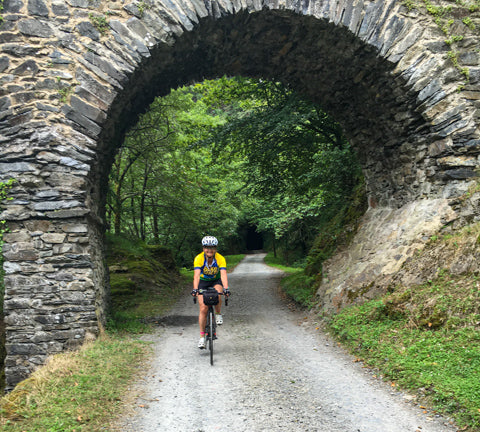 |
Drive - Zarautz to Pechón
The next day was time to leave Zarautz. Heading West and once again travelling the magnificent northern Spanish coastline, past Bilbao, always avoiding the motorway, we turned away from the coast onto the backroads and into the lush green hilly countryside leaving Basque country and entering the province of Cantabria. Being a Sunday, we stumbled across a small country show in the village Valle de Villaverde with farm animals, farm produce and a brass band. We felt quite at home with the country folk. Continuing through many small villages, skirting Santander, crossing the Rio de Tina Menor and returning to the coast at Pechón, which was our next stopping place for three nights. A delightful small village with a clifftop walk through cattle fields and down to the beach - Playa de Amió – a small sandy cove with 2 shores scooping out to reef, resulting in a tidal island.
Cycling Day 9 Pechón - Llanes - Poo – Celorio - Pechón. 71km 628vm. 1st August
Cycling further west, along the Atlantic coast, crossing the Rio de Tina Mayor to the port town of Llanes. Roads turning into steps up through the town meant hoisting our bikes onto our shoulders to progress on our exploration of this old, medieval town. A village named Po that appeared to have some identity crisis with signage and graffiti referring to it as Poo, Póo and Po. We ventured as far as Celorio, with a visit to Playa de Celorio before retracing our route to Pechón. Total freedom and joy as we were once again soaked in the Atlantic Sea air.
 |
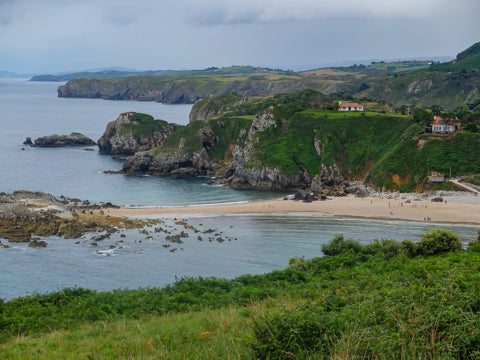 |
Drive - Picos de Europa
The following day was a drive into Parque Nacional de los Picos de Europa (the Peaks of Europe) via Panes and Potes. Along narrow river gorges and into Fuenta Dé for an amazing valley walk gazing at these awesome mountains, steep, jagged peaks with sheer rock faces towering over the valleys, rivers and lakes. We quickly realised this was a place to return to, especially for nature lovers, walkers and climbers. Our single day seemed very inadequate in this beautiful place. These mountains had been shrouded in clouds for the last week but today they were fully on show in bright sunlight.
Our return to the coast took in the waterfront towns of Comillas and San Vicente de la Barquera – both beautiful. So many of the coastal towns being on river mouths coming down from the heights of the Picos de Europa.
Cycling Day 10 Pechón to the beach and back. 6km 3rd August
An early farewell ride to the beach to fill our lungs with Atlantic sea air – a simple ride along the clifftop road to our local beach and to the camping ground at the mouth of the Ria de Tina Mayor.
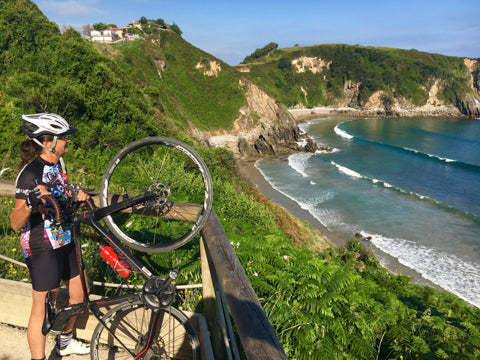 |
Drive - Pechón to Elciago
Time to leave the north coast of Spain and head south and inland to wine country. From Pechón in Cantabria, along the Valee de Cabuerniga, up through alpine meadows, over the mountains at Pueto de Palombera (1260m). Here we came across pro cycling teams and cycling groups riding the mountain pass, cows and calves, horses and foals grazing the mountain pastures with their neck bells creating melodies echoing across the valleys, delicate mountain flowers, Saja-Besaya nature park, stone houses, dry stone walls, down to the fertile valleys of the Ebro River. A total change in landscape and climate as we enter the plains of production – fields of sunflowers nodding their heads, harvested crops, and the start of vineyards.
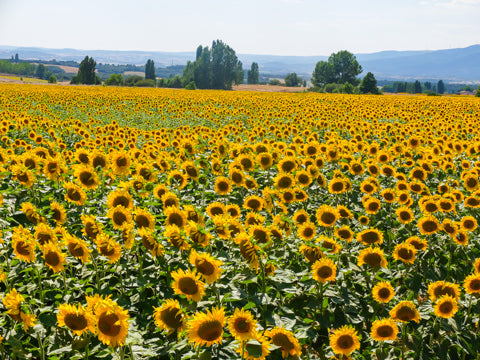 |
A mosaic of colours and textures and gentle movement. Some road works and detours meant we were popping in and out of Basque Country and La Rioja. Our entry into the Rioja Wine Region was announced by the large silhouette statue of a black bull standing on the hill. Vineyards on all available land, leaving bare, craggy hillocks in between. The temperature had increased, and it was a change from the cooling of the Atlantic to the hot and dry interior. We finally found our way through the village of Elciago to our Agroturismo Valdelana where we were staying for the next 4 nights. We had come to the Rioja Alavesa Wine Region, between the Ebro River and the Cantabrian Mountain Range where vines have been grown since Roman times. A region with 23 towns and villages and around 400 wineries. Truly a region purely focused on wine and hospitality. Having worked with a wine maker who had done several vintages in Spain, we were keen to see this region and taste the wines.
Cycling Day 11 Elciago – Navaridas – Laguardia – Elvillar – El Campillar - Lapuebla de Libarca - Elciago 38km 721m vm 4th August
Last night we discovered that the village of Elciago comes to life after 9pm. The streets were deserted from 6-9pm, then families begin to appear in the Main Square, and start to fill the bars and restaurants and the children fill the square with their games and laughter.
 |
Exploring the town of Elciago on foot to get our bearings and find some maps, then breakfast and coffee as we plot our next couple of days in this region. First a tour and wine tasting at Bodega Valdelana where we are staying.
It was much hotter today, so we didn’t start our ride until after 4pm, returning at 9pm. We chose a route that would wind us through the wine region. We were amazed at how unlike the wine regions of home this region of Spain was. The dry stony ground with a patch work of vineyards interspersed with little barren, rocky hills and olive groves. Every available piece of growing soil had a vine in it. Through Navardias, then a steep climb to be rewarded with the walled medieval town of Laguardia, with stunning views over Rioja Alavesa vineyards.
 |
We detoured to visit another architectural masterpiece at Ysios Bodegas, before returning through Lagaudia and continuing on.
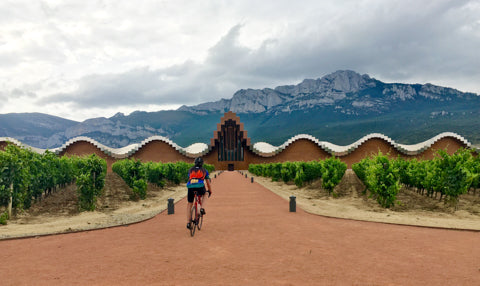 |
The clouds built, and the wind set in, at first cooling but becoming so strong it was beginning to buffet the bikes from the side. We wandered from village to village which were nearly always built on the non-productive hilltops. Astounded by prehistoric settlement remains – the Dolmen rock structures near Elvillar. The Witch’s Hut - La chabola de la Hechicera is a dolmen group. Three large vertical stones support a large horizontal flat stone and nine large stones form a chamber. The corridor is made of five stones and is divided into two. Believed to be burial chambers dating from 2500-4000 BC. We rode past many architecturally magnificent wineries, stopping often to inspect vineyards. As we descended back into Elciago, we came across the ultra-modern Hotel Marqués de Riscal designed by Frank Gehry who also designed the Bilbao Guggenheim Museum.
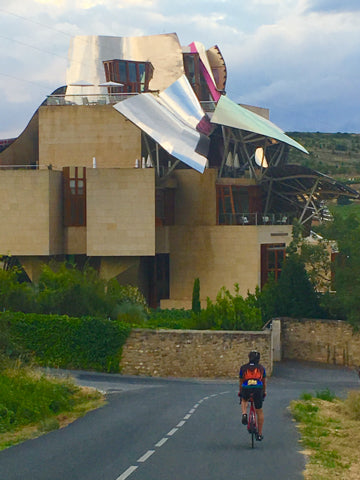 |
Our evening standard practice had quickly become to walk into the town square, find a Vinoteca for wine and then dinner at the good Spanish time of 10.30pm.
Drive – Rioja wine region
After getting a feeling for the region yesterday on our bikes, we decided to drive further afield and call into some of the bodegas (wine cellars). Baños de Ebro to Briones to Haro. Here we visited the Barrio de la Estacion – Haro Station District – a neighbourhood which has a concentration of at least 6 historic wineries and warehouses in a unique urban setting gathered close to the railway line. We then continued to Labastida, Logrono and back to Laguardia which we'd already seen yesterday. Founded in the 10th century as a defensive military fort on a hilltop overlooking valleys. We toured the tunnels/caves which were originally built as hiding places and escape routes into the hills, in more recent centuries used for wine storage and cellars (calados). This medieval town with a maze of narrow streets is vehicle free because of the network of tunnels constructed under the old town.
 |
Cycling Day 12 Elciago – Cenicero – Najera – Elciago 38km 303 vm. 6th August
An early start in the cool and quiet of the morning for our flatter cycle tour over the Ebro River to Cenicero and Najera and the Najerilla Valley, one of 7 rivers feeding into the Ebro, and return. Vineyard workers busy watering, pumping, spraying, tractors working and not many other people around and the roads really quiet. Soils in these valleys appear redder, more loamy and less rocky than in the Alevesa. Endless vineyards and villages only 4-5 km apart.
 |
Drive – Elvillar, Labraza and Labastida
The rest of the day we took the car again – there is just so much to see in this region. On the outskirts of Elciago we again visited the fabulous Hotel Marqués de Riscal – this time for a walk through.
Then a tour of the back roads and small villages, some we had cycled through, but wanted to see again. First stop Elvillar - parked outside the village and walked in. Note to travellers in this region: Enter small walled villages at your own risk. Suggest carrying a baguette to leave a trail of breadcrumbs. Remember which side of the street the shade is on and always return to the church when you can glimpse its spire. Every street and every turn look the same. Continuing to the living walls of Labraza with towers and turrets featuring around the walls.

Crossing through the Sierra Cantabria it was time for a picnic stop under the oak and maple trees. Descending into another valley with fields of sunflowers gently bobbing their heads, but with no vineyards north of the mountains. Passing through many small villages and arriving in Labastida we discovered they were in Fiesta mode - a pigskin full of red wine suspended on wires between buildings surrounding the main square. The square suddenly fills with people, dressed in white, so they are shoulder to shoulder and the pig skin then gets lowered (almost zipline style) across the square spilling and splashing its contents randomly in a shower of red wine. The idea is to catch some wine in your mouth or a cup or get wet and the red stained white clothing is proof of their success. There was a bull also let loose in the crowd, We by mistake were in that crowd. Oops – a quick climb up the fence was required.
A stop on the return to examine a Chozo - old huts that look like classic Winnie The Pooh beehives.
Drive – Elciego, Spain to Luz-Saint-Sauveur, France
The next day was time to farewell Spain and cross into France. Avoiding motorways, it was a long and winding road, through many villages, skirting Pamplona again. Crossing rivers, through wind farms, narrow mountain roads, forests, valleys, finally climbing to Roncevalles over the pass and parallel to the French/Spanish border until we got to Arneguy when we crossed into France. We only realised we’d crossed when road signage suddenly changed. First stop in France was Saint-Jean-Pied-de-Port but still in ancient Basque country.
A change in buildings with more grey slate, bright flower boxes, rivers and finally to the famed city of Lourdes. From here we needed to head south again deep into the Pyrenees to our next destination of Luz-Saint-Sauveur where we were staying for the next 5 nights. Our hotel was a little out of town which provided a good opportunity to walk and explore the town. It was overlooking the Gave de Gavarnie (torrential river) passing through a deep gorge. Despite being on the third floor the roar of this river took a little getting used to when we were trying to sleep.
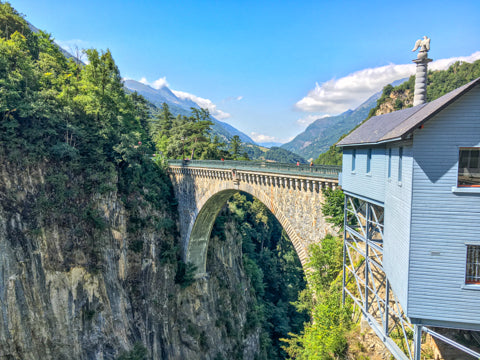 |
Cycling Day 13 Luz-Saint-Sauveur – Gavarnie-Gèdre - Col de Tentes at 2208 metres a ride of 58km 1477 vm 8th August
We were now deep in the Hautes-Pyrénées department in south-western France. We decided to ride out of town in the opposite direction to the way we had entered. Perhaps it would give us a little practice and warm up cycle for our attempt on the Col du Tourmalet which we were attempting in a couple of days. It took us to Gavarnie-Gèdre, where we stopped, wandered and had some food and drinks. Feeling refreshed we decided to keep going up and see where it takes us! If we’d looked at a profile, we would have been frightened off. Little did we know we had just taken on the Col de Tentes full of switchbacks with local cattle and sheep sometimes on the road. What a climb, but an incredible rewarding view once we reached the top, where only walkers could continue to the Spanish border. Part of the Cirque de Gavarnie and part of the UNESCO World Heritage Site Pyrenees – Mont Perdu. We just dropped our bikes on the grassy summit, walked around and took in the extraordinary views. Climb of a lifetime.
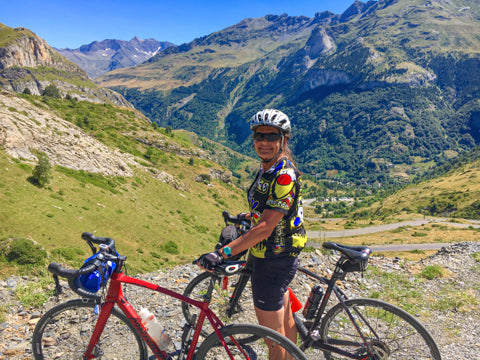 |
Our rest day after this climb was a drive down the valley to Arras-en-Lavedan, a good choice as it turned into a rainy day.
Cycling Day 14 Luz-Saint-Sauveur - Col du Tourmalet & return 41km 1562 vm 10th August
The highest road in the Pyrenees at 2115 metres – we rode the west side climb from Luz-Saint-Sauveur. Featured in the Tour de France (TDF) many times (over 87) earning it the fame and notoriety as one of the Big Three Climbs of the TDF and one of the must do rides for cyclists. With an 8am start to get away before the traffic built, sunshine in the valley, the clouds hovering on the peaks, the wind was icy as we reached the famous line at the Col (all be it in turtle time). Having to use our farming skills on the ascent to keep us moving upwards to ‘shoo’ and whistle at some sheep who seemed to want to own the road. It was quite emotional when we realised, we’d made it to the top and ticked off another of our trip goals. There was not a lot of space at the top - camper vans, motorbikes, cars, and lots of cyclists, all trying to stop to take in the views and have a quick drink at the bar.
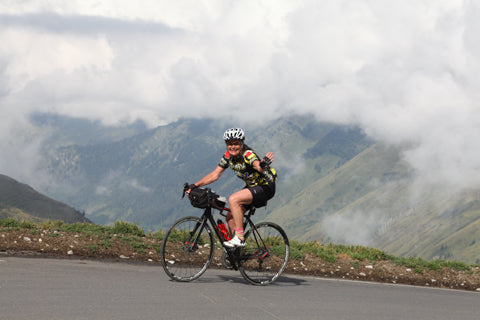 |
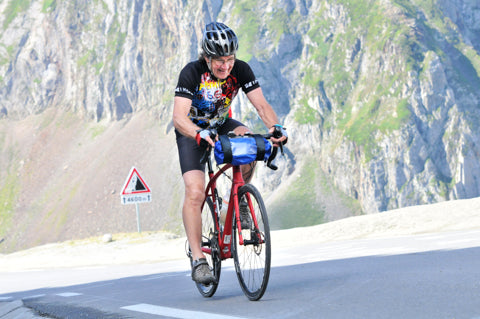 |
 |
It was too cold to stay long, donning wool singlets, long sleeves and a wind breaker and pulling up the long socks, it was time for the long descent. 20km of pure downhill amongst traffic, no barriers and many switchbacks. Part way down, we were forced to stop as a group of goats was taking up the entire road as they headed up the mountain.
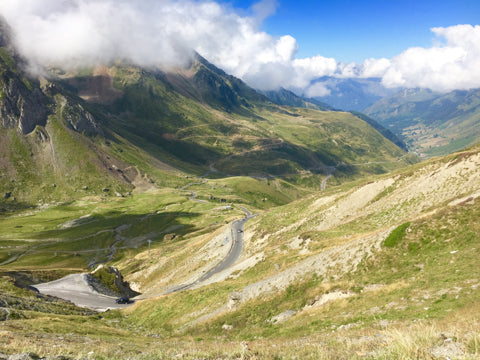 |
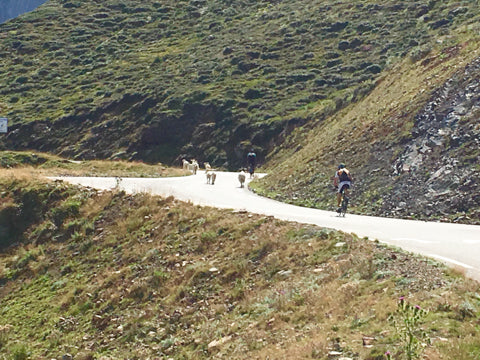 |
With constant feathering of disc brakes, setting a good line, stopping occasionally for photos, we returned to Luz-St-Sauveur safely. Shivering with cold but rather ecstatic, we were soon revived with a fabulous pizza and hot chocolate whilst sitting in the sun and listening to some local musicians. Col de Tourmalet average 7.4% over the 20km. Last 12 km average of 9%. Height 2115m.
Cycling Day 15 Pierrefitte-Nestalas via La Voie Verte des Gaves to Lourdes & return 46km 325vm 11th August
Definitely a recovery day with a drive to Pierrefitte-Nestalas to the start of La Voie Verte des Gaves to take us to Lourdes and back. A relaxing ride along a great track, 45 km round trip with a flattish valley run along an old railway line. Through lots of small Pyrenees’s villages. Ride done, then a quick car trip up another valley to the busy mountain village of Cauterets. A mountain bike paradise with a cable car to return them to the top.
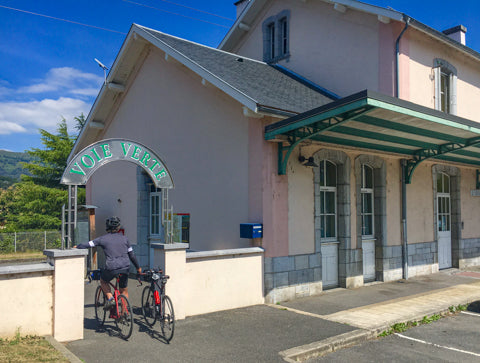 |
Our favourite meal we have to mention was the local trout – the “fario” or brown trout from the cold and oxygen rich waters of the Pau River.
The following day was farewell to beautiful Luz-St-Sauveur, driving down out of this valley, then eastwards along the Pyrenees foothills and into the Midi Pyrenees - Pyrenees Ariegeoises. This drive was along all the quiet back roads, and it felt like we were in the same territory as the story of Nancy Wake (The White Mouse) - WW11 French Resistance heroine who took a very important bike ride through this region. The next 6 days we stayed in a fabulous old BnB near the village of , Castelnau-Durban, tucked away up a country lane with a mountain stream running through its lush 5 ha garden. The car proved useful to do a reconnoitre of the area and plan some rides.
First a trip to the St Girons markets - beautiful setting under avenues of trees. Then off exploring the hills, up the valleys, through the cols, down the hills, farmers’ single lane roads, steep climbs, narrow winding roads, Biert, Massat, Foix.
Cycling Day 16 Saint-Pierre-de-Rivière – Col de Péguère – Saint-Pierre-de Rivière (Foix), 52km 1045 vm 14th August
Choosing a starting point just out of Foix, 4km below the signed start of the climbs in the village of Saint-Pierre-de Rivière. The day was hot and we managed the 26km of climbing by midday. First climb to Col des Marrous at 990m & 13.5 km. Next it was Col de Jouels at 1247m, followed by the climb to Col de Péguère at 1375m. Then the final climb and ridge run to Col de Portel at 1432m. With stunning views and many hikers and locals enjoying picnics in the mountains. A speedy descent down 26km in a lot shorter time and it was time to treat ourselves to beer, lunch and coffee in Foix.
 |
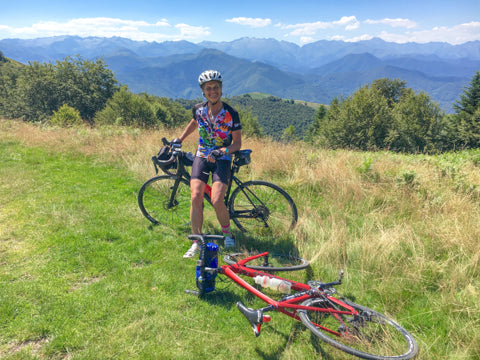 |
The next couple of days were cycle free but very special celebrating a significant birthday. First a drive to the mountains for a picnic with a view to celebrate the end of a decade. We drove via St Girons to Col de Latrape and to the ski village at Guzet then on up on the gravel goat track of a road and finally to the top ski lift station, and the scenic outlook from Plateau de découverte Cap de Guzet. Looking out onto the high Pyrenees peaks, sitting on the grassy edge of the mountain and taking in the magnificent views all around. Many young mountain bikers being driven to the top to ride the many downhill runs. Sunny and glorious at first, then clouds built, quickly followed by heavy rain and a thunderstorm. This cleared and we walked right to the top. Clouds built again, the sky started rumbling again, and it was time to go down the mountain.
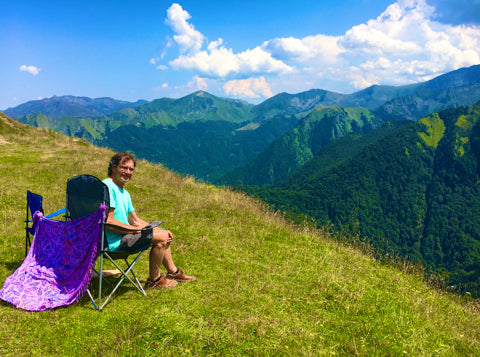 |
Part way down we were forced to stop and wait while a fierce hailstorm passed over. The noise was fearsome, and torrents of water were gushing down the road. A welcome break in Seix for hot chocolates for a rest from the fierce storm before heading home via St Girons and Saint Lizier. An ancient hilltop village listed as one of the most beautiful villages in France.
The next day a road trip to the ancient citadel of Carcassone to celebrate this significant birthday. Very touristy and busy but nice to visit again after so many years. The countryside was bright with sunflower fields, vineyards, and garlic fields and beautiful plane tree avenues. We were glad to return to our country hideaway to be spoilt with dinner, a bottle of champagne and a chocolate cake and candles from our hosts.
Cycling Day 17 Castelnau-Durban - Le Mas-d'Azil - Lac de Mondely - Castelnau-Durban 49km 695 vm 17th August
Our final day of cycling on this trip was a real adventure - up hills, down hills, through farms, market towns for lunch, through a cave, along rivers, through forests, to a lake with a beach, even meeting the postie van 3 times. Intriguing roadside Raynaude church with its burial ground set into the hillside. Following the Arize River the road took us through Grotte du Mas d'Azil – with prehistoric cave paintings and artefacts on display. Definitely needed our lights on, as it was very disconcerting when the local tractor and baler come charging through the cave taking up most of the road. In the village of Le Mas-d'Azil we chanced upon their market morning with lots of local artisans.
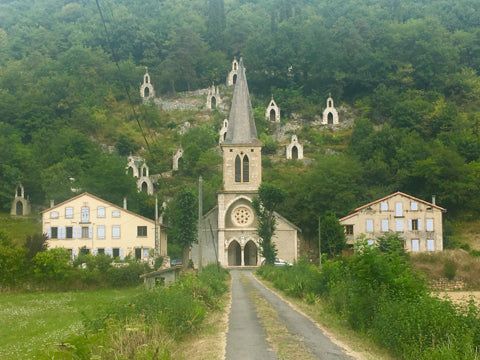 |
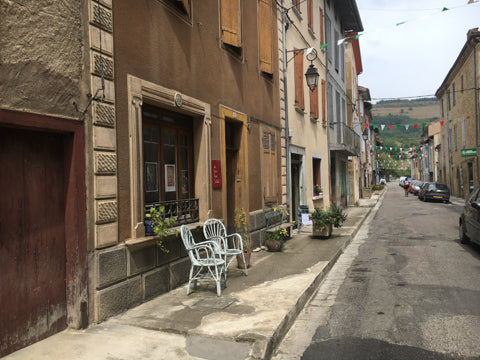 |
We discovered Lac de Mondely with a beach which proved too tempting, and a swim was in order. After a down there is always an up – and true to form - up a really big hill on a 'farmers track” with hairpin bends, on and on it went through forested hillsides and small fields, twisting and turning, past small farmhouses and stone buildings. Finally reaching the top, we rolled along the crest of the hills before the welcome descent into the valley below where we returned to our lodgings.
Our cycling journey took us on an adventure of a total of 622 km over 17 cycling days climbing 9950 metres.
... and the rest...
From here we had another week to return to Barcelona for our flight home. First through the stunning gorges de la Pierre-Lys, vineyards, and olives around Maury, to Perpignan then south to the Spanish border. Quickly passing the unnerving commercialism and transit nature of the 2 border towns of Le Perthus and La Jonquera, through Figueres to find our next hostess, Dolores in Galliners, an AirBnB in a traditional Spanish farmhouse. Sent out to dinner at a traditional country Catalan restaurant, Can Roca in Esponella, we relied on the GPS to guide us home in the dark with directions such as 'hard left, sharp right, straight then hairpin left”.
Sea air once again as we reach the Mediterranean and the Costa Brava at l'Escala. Beach promenading and lunch on the beach.
 |
Then our pre booked visit to the Salvador Dali Teatre Museu and the Dali Joies (Jewels) in Figueres. To be seen to be believed, a couple of hours of artistic mind-blowing viewing, before finishing another perfect day with a fab meal at a local restaurant in Bascara.
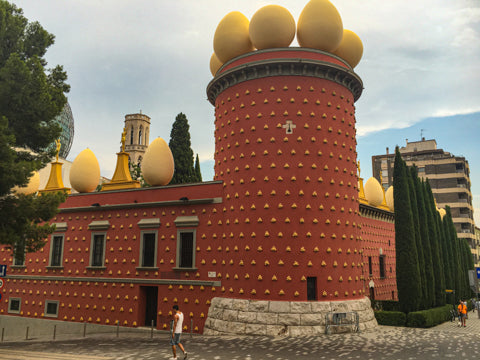 |
The final journey took us via the Parc de Volcanos and the towns of Santa Pau and Olot through forested hills and mountains. Then a surprising road, the C37 with several viaducts passing over the valley and at least 9 tunnels through the hills, to keep the road flat, back to Torello, Vic and finally back to Barcelona for our final 4 nights in this vibrant city. Day 1 of walking was a private city tour with a beautiful Bohemian Dutch artist living in Barcelona with her Catalan family – lots of walking and discovering the lesser-known sights, history, culture, art and architecture of this beautiful place. Day 2 of walking with La Boqueria markets for breakfast, the busy Las Ramblas Avenue, seeking out the best paella for lunch, then a long walk along the beach, followed by an evening ramble. Barcelona is such a colourful place.
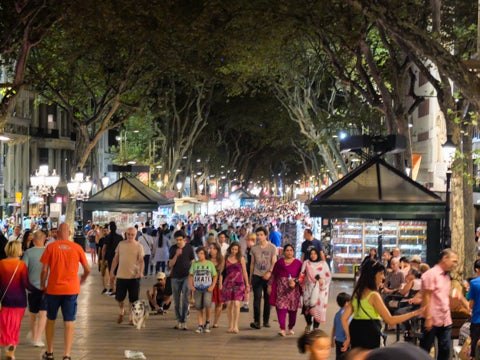 |
Day 3 of walking was time to see Antoni Gaudi’s creations with the La Sagrada Familia, his apartment blocks and Parc Güell. La Sagrada Familiar is beauty beyond description. The use of nature in architecture to create a majestic space of light and wonderment. Whatever your belief you have to be amazed at this. A project started in 1882, we saw this in 1981 and 1987 and it is scheduled to be completed after 2026.
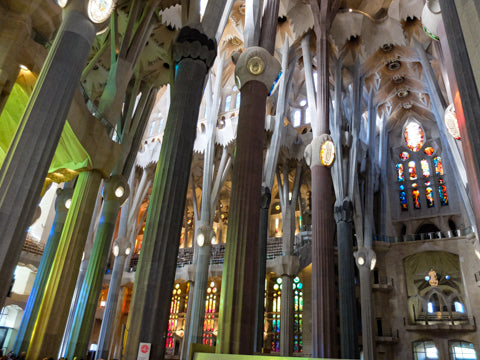 |
With all our boxes ticked it was time to fly home and plan our next adventure. With wonderful memories of our travels in Spain and France: The Pyrenees and Basque Country, fine food, Tapas, Pintxos, seafood and river trout, Cider, beer, wine, jambon, Basque history, laneways, geraniums, hydrangeas, donkeys, dogs, farms, stone bridges, stone houses, oak trees, chapels on hilltops, olives on terraces, vineyards, vultures soaring high, rocky mountains, steep valleys, hilltop villages, rock arches over roads, butterflies, summer chatter of crickets (cicadas), thunderstorm with rain and hail in the mountains, green hillsides, mountain streams, forests, agriculture, fields of sunflowers, siesta time, nightlife, dinner after 9pm, sunset at 10, beach/coastal promenades, culture, history, art, architecture, language, friendly people and joie de vivre.
... Jen & Greg (published March 2023)
We undertook this adventure in 2016 - but I'm sure the beauty of this region hasn't changed.
See map at the end of this blog.
Accommodation:
- Hotel Dos Rios, Ainsa.
- Casa Ursula, Anso
- Hostal Arriazu, Pamplona
- Argoin Txiki Nekazalturismoa, Pagoeta Bidea, Zarautz
- Posada Meliante, Pechon
- Agroturismo Valdelana, Elciego
- Hotel Panoramic et des Bains, Luz Saint Sauveur
- Tourné Chambres d'Hotes, Castelnau-Durban
- Marquina, Galliners, Catalunya.
- Clutat Vella, Tallers, Barcelona
 |
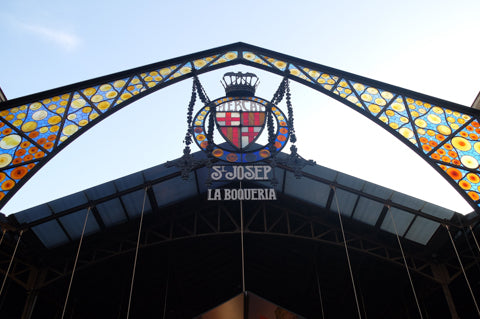 |
|
Starting and finishing in Barcelona, Spain. 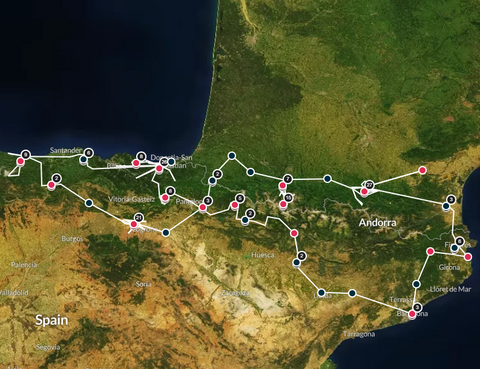 |


0 comments